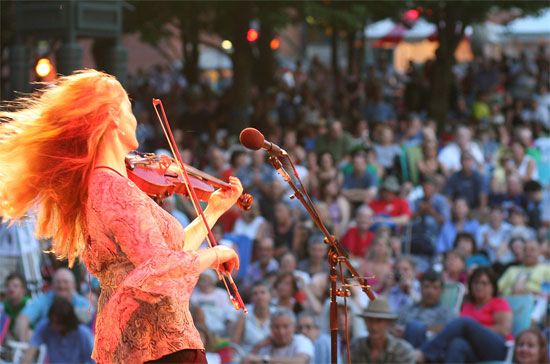‘Saturday, Saturday…’
I’ve been to every Folk Festival since the first National Folk Festival in Lowell in 1987, and the 2010 Saturday was as good as I’ve seen it—the talent, the street life, the audience size, the urban energy. I spent a lot of time at Boarding House Park with the UMass Lowell booth. The crowd never quit from 12 noon to 9 p.m., when we folded our tent for the day. We answered hundreds of questions about university programs. We handed out about 1,000 free foam visors printed with the school logo; several thousand different brochures, newsletters, booklets, fliers, sports schedules, event tabloids, and postcards about various campus programs; and 12 pounds of free hard candy. Everyone was in great spirit and took the scorching temperature in stride. It was hot, but it didn’t rain—that’s all that mattered.

At Boarding House Park the acts were top notch, particularly the Steep Canyon Rangers (a strong candidate for best group name this year), Bua (traditional Irish, introduced by Seamus Connolly, I think it was), De Temps Antan (French-Canadian roots music), and the Kings of Harmony, who paraded their jazzy brass sounds into the park. I heard Cape Verdean songstress Maria de Barros and her band at the Dutton Street Pavilion, where she had the dancers swinging to “funana,” which the LFF website describes as a “zydeco-like dance form with strong African roots, rhythmically powered by the ‘ferro,’ a piece of metal scraped with a smaller metal object.”
A few observations:
The transformation of the National Park parking lot into the Dutton Street festival area is one of the best changes that has been made in recent years. The area rivals the Boarding House Park zone for dynamism, and it’s great to have the activity on the doorstep of the Market Mills complex and the Park Visitor Center. It functions as a vibrant front plaza and lively back yard at the same time, depending on which direction you enter the Festival zone from.
Jerry Beck’s place at the corner of Shattuck and Middle streets is back “on line” as an art gallery. On exhibit are many works by Jerry—drawings, multi-media pieces, sculpture—that remind people why he has a national reputation as a maker of art. His “boot series” is worth going in to see. Admission is free.
The people-watching was Olympic-level all day. If this isn’t a people’s festival now, I’ll eat my foam visor. In the early years of the Festival, the audience tilted toward the Channel 2/WGBH Radio-type folk aficionados—not that there’s anything wrong with that. Now, the great American democracy is on display—and there’s everything right about that.
Walking through downtown at about 9 p.m., I heard (and saw) music pouring out of every business that had a cup or a table to its name. In front of Mambo Grill a reggae band featuring horns powered through bouncy covers of Bob Dylan and Bob Marley. The frontman wore a black t-shirt with a big John Lennon image on the front. There was a woman in a white sun-dress on the side slow-dancing with a gray-beard vet in a wheelchair. The guy was twirling his chair to spin her around. Merrimack Street was still a pedestrian way at that hour and became a performance canyon as the music climbed the building facades and deflected off tall windows. At the Old Court’s improvised outdoor seating area a large crowd soaked up some searing electric blues. The audience was still building at that hour, with people streaming down Central Street into the “3-M District” (Market-Middle-Merrimack). Near the intersection of Central and Merrimack streets I saw a crowd circled around something—I couldn’t see what was in the middle. About 100 young people were huddled up and somebody was calling out or rapping in the center. I got to the back edge of the circle, but couldn’t tell what was going on. There’s something to be said for shutting down the traffic to stimulate nightlife downtown. It wasn’t quite as busy as Times Square, but it was a pretty good Lowell-scale version of big-city nightlife.